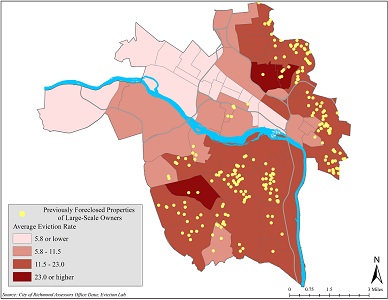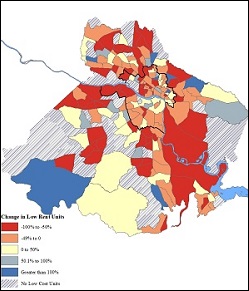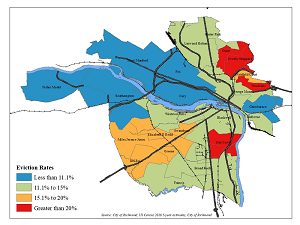RVA Eviction Lab
Please visit our new website at https://rampages.us/rvaevictionlab/
Why have we formed the RVA Eviction Lab?
Richmond has the second highest eviction rate in the country, 11% annually from 2000 to 2016, based on the Princeton University Eviction Lab analysis of millions of eviction case court records. Five of the top ten cities in the US with the highest eviction rates are located in the State of Virginia. Richmond, Roanoke, and Hampton Roads faced the highest rates of eviction, demonstrating a statewide challenge. High eviction rates are disproportionately found in minority communities, with more than 60% of all majority African American tracts facing eviction rates greater than 10%.
With the Princeton University Eviction Lab data drawing attention to this issue, the Virginia Poverty Law Center brought together advocates and service providers to create the Campaign to Reduce Evictions (CARE). CARE identified the need for additional data and analysis to drive policy and advocacy in reducing the displacement of families facing eviction.
The RVA Eviction Lab, housed at VCU within in the Wilder School of Government and Public Affairs, focuses on meeting eviction data and research needs and supporting the work of local government, community-based organizations, elected officials, and other advocates. The RVA Eviction Lab takes the necessary deeper dives into the qualitative and quantitative aspects of evictions. Because this problem and the associated research questions will continue to shift both regionally and locally, we make data public, reliable, and responsive to the needs of the community, region, and the state.
Who Are We?
Kathryn Howell, co-director
Dr. Howell investigates ways to interrupt ongoing patterns of migration, displacement and segregation in cities. Her work focuses on affordable housing and public spaces to explore redevelopment, displacement and governance. She has specifically looked at the preservation of affordable housing in Washington, DC, examining the intersection between policies, governance and the built environment. She was previously a practitioner in local government developing housing and community development policy in Washington, DC and Maryland agencies.
Ben Teresa, co-director
Dr. Teresa studies the changing relationship between finance and cities. His research examines how the increasing role of financial institutions, actors, and logic—sometimes referred to as the “financialization” of the economy—affects urban development and governance and how communities and planners exercise control over the institutions that shape how cities change. Teresa’s research engages across multiple topics including real estate development, housing, tax incentives, artistic and cultural production, and urban education. His current research focuses on the reemergence of land contracts and the role of institutional investors in reproducing racial segregation in real estate markets. He has published this research in Environment and Planning A, Urban Geography, and Urban Affairs Review.
Comparative Law and Policy Analysis for Addressing Evictions in Richmond, Virginia
Woody Rogers and Leah Demarest
October 2019
RVA Eviction Lab
SUMMARY
The City of Richmond has the second-highest eviction rate of all large U.S. cities (Eviction Lab, 2016). Since the publication of a New York Times article in 2018, the community has been compelled to face the eviction crisis head-on (Badger & Bui, 2018). Understanding laws and policies that other states and localities have enacted to reduce eviction serves to inform community leaders in Virginia of potential remedies to this crisis. This report outlines several laws and policies applied across the country that address eviction at various stages in the process. Demonstrating the multiple entry points for intervention, these policies are divided into three groups:
- Decreasing evictions by providing additional protections for tenants before and during eviction processes;
- Lessening the severity of evictions by mitigating the impact of evictions on health, future housing, and job or educational stability; and
- Curbing eviction through housing policy by expanding access to safe and affordable rental housing.
While far from an exhaustive catalog of laws and policies, this overview offers insight to policymakers in the Richmond region of possible interventions to address the current eviction crisis.
For more detailed information about the laws and policies presented in this research brief, as well as specific jurisdiction examples, please see the appendix and supplemental table of laws and policies.
Research Brief_Eviction Laws and Policies_Oct 2019
Table_Eviction Laws and Policies_Oct 2019
Appendix_Eviction Laws and Policies Brief_Oct 2019
The Connections between Evictions and Foreclosures in Richmond
Woody Rogers
RVA Eviction Lab
SUMMARY

Data published over the past year illustrates the severity of the eviction problem in the City of Richmond. However, we currently know little about how previous housing instability has affected eviction rates. Like many places across the country, Richmond suffered from the collapse of the housing market in the middle of 2007 and experienced high rates of foreclosure, with the most severe impacts felt in communities of color. Through geographic analysis of the two forms of housing instability, this study seeks to understand the spatial relationship between foreclosure and eviction in the City of Richmond, as well as understanding the role of large-scale ownership in displacement.
This report outlines findings that the areas of Richmond with high eviction rates - south, east, and northeastern neighborhoods - also experience high rates of foreclosures. Additionally, neighborhoods with the most extreme concentrations of evictions also have some of the highest foreclosure rates in the city. Finally, identification of the five largest landlords of previously foreclosed homes across the city and their eviction records indicate that such owners evict at high rates, more than 7% above the city average. These findings indicate the interconnectedness of the two forms of housing instability, eviction and foreclosure.
Download full article The Connections between Evictions and Foreclosures in Richmond
Eviction and the Rental Housing Market in the Commonwealth
Kathryn Howell, PhD
RVA Eviction Lab
SUMMARY
 Communities across the Commonwealth of Virginia face high rates of eviction that can lead to neighborhood instability. At the same time, the state faces a shortage of affordable housing and high rates of cost burden and extreme cost burden. Families experiencing high cost burden have little room for error in their monthly budgets, meaning that one bad day can translate into an eviction that causes significant housing instability, including multiple moves or homelessness.
Communities across the Commonwealth of Virginia face high rates of eviction that can lead to neighborhood instability. At the same time, the state faces a shortage of affordable housing and high rates of cost burden and extreme cost burden. Families experiencing high cost burden have little room for error in their monthly budgets, meaning that one bad day can translate into an eviction that causes significant housing instability, including multiple moves or homelessness.
Across Virginia, almost half of all renter households are housing cost burdened, meaning that they pay more than 30% of their incomes for housing. These numbers become more extreme when broken down by income. Table 1 illustrates rent burden by income and region. Extremely Low Income Households (ELI), or those earning less than 30% of the Area Median Income (AMI) have the highest cost burden at 87% statewide, followed by Very Low Income (VLI) Households, or those earning between 30% and 50% of AMI at 80%. Meanwhile, statewide, 72% of ELI renter households face extreme cost burden, meaning that they pay more than 50% of their incomes for housing.
Previous research from the RVA Eviction Lab found that even controlling for income, race and other factors, housing cost burden was a critical contributor to rises in the eviction rate at the neighborhood level. This paper examines the existing housing stock, primarily in the Richmond region to understand the relationship that cost burden may have to high eviction rates in the region. We find that a robust housing preservation and production strategy must focus on housing for households earning less than 50% of the Area Median Income to reduce rent burden and prevent future evictions.
Download full article Eviction and the Rental Housing Market in the Commonwealth
Eviction and Educational Instability in Richmond, Virginia
Kathryn Howell, PhD
RVA Eviction Lab
SUMMARY
 Richmond faces an eviction rate of approximately 11%, which has remained steady over the past 16 years. However, evictions are unevenly dispersed across the city with neighborhoods in the east and south sides of the city facing significantly higher rates. The impact of high eviction rates in these neighborhoods are exacerbated by relatively high percentage of rental housing, particularly in the Southside and Northside. Conversely, west end neighborhoods where eviction rates are low also have limited rental housing, meaning that there is limited neighborhood turnover because of eviction. While evictions touch individual households, schools are increasingly the front line of eviction, impacting educational and behavioral outcomes for both mobile students and those who are in schools facing high rates of mobility. In this brief, we explore the impact of eviction on Richmond Public Schools (RPS). We find that majority white school districts face significantly lower rates of eviction that those with African American or Latino majorities. More importantly, those schools also face higher rates of chronic absenteeism and mobility.
Richmond faces an eviction rate of approximately 11%, which has remained steady over the past 16 years. However, evictions are unevenly dispersed across the city with neighborhoods in the east and south sides of the city facing significantly higher rates. The impact of high eviction rates in these neighborhoods are exacerbated by relatively high percentage of rental housing, particularly in the Southside and Northside. Conversely, west end neighborhoods where eviction rates are low also have limited rental housing, meaning that there is limited neighborhood turnover because of eviction. While evictions touch individual households, schools are increasingly the front line of eviction, impacting educational and behavioral outcomes for both mobile students and those who are in schools facing high rates of mobility. In this brief, we explore the impact of eviction on Richmond Public Schools (RPS). We find that majority white school districts face significantly lower rates of eviction that those with African American or Latino majorities. More importantly, those schools also face higher rates of chronic absenteeism and mobility.
Download full article Eviction and Educational Instability in Richmond
The Geography of Eviction in Richmond: Beyond Poverty
Benjamin F. Teresa, PhD
RVA Eviction Lab
SUMMARY
Download full article The Geography of Eviction in Richmond: Beyond Poverty